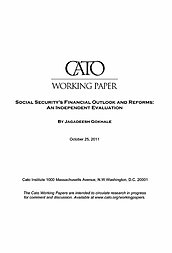But Social Security reforms should also be implemented under accurate and full information about the program’s financial condition. Also needed is a proper appreciation of the effects of alternative reforms on the program’s overall financial condition and on the costs and benefits imposed on various participants’ future finances — the young and old, rich and poor, male and female, and so on.2 But official evaluations of the program’s fiscal condition and its projected finances are conducted using methods and metrics that should be considered long outdated. Moreover, analyses of distributional effects, especially over participants’ lifetimes under current policies, are not included in the trustees’ annual reports on Social Security’s finances. Although the topic of Social Security almost always generates a robust debate, it is likely to be misguided under the projections and analysis provided by the program’s trustees and actuaries. The purpose of this paper is to highlight the availability of better methods and metrics for evaluating Social Security’s future finances and for assessing the reforms that have been proposed by lawmakers, academics, budget analysts, and others.
Social Security’s Financial Outlook and Reforms: An Independent Evaluation
Social Security is often described as a “foundational” element of the nation’s social safety net. Almost all Americans are directly affected by the program and many millions primarily depend on its benefits for supporting themselves during retirement.1 But the program’s financial condition has worsened considerably since the last recession, which began in 2007. In that year, the Social Security trustees estimated that the program’s trust fund would be exhausted by 2042. The trustees’ annual report for 2011 brings the trust fund exhaustion date forward to 2038. Indeed, the programs revenues fell short of its benefit expenditures in 2010 and it appears unlikely that significant surpluses will emerge again under the program’s current rules. If the program’s finances continue to worsen at this rate, it won’t be long before the debate on reforming the program assumes an urgency and intensity similar to that during 1982–83, when imminent insolvency forced lawmakers to implement payroll tax increases and scale back its benefits.

